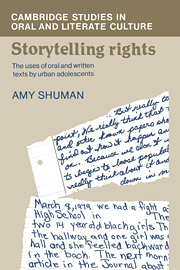Book contents
- Frontmatter
- Contents
- Acknowledgments
- Introduction
- 1 Fight stories: what counts is the recounting
- 2 Storyability and tellability
- 3 Collaborative uses of literacy in the adolescent community
- 4 Retellings
- 5 Varieties of contextuality
- 6 Familiarity and distance: toward a theory of oral and written personal narration
- Notes
- Bibliography
- Index
- Frontmatter
- Contents
- Acknowledgments
- Introduction
- 1 Fight stories: what counts is the recounting
- 2 Storyability and tellability
- 3 Collaborative uses of literacy in the adolescent community
- 4 Retellings
- 5 Varieties of contextuality
- 6 Familiarity and distance: toward a theory of oral and written personal narration
- Notes
- Bibliography
- Index
Summary
Marci: If Marie's the one who always gets into fights
how come you're the one who's always in trouble with the teachers?
Stacie: Cause Marie do the fightin' and I do the talkin'
Although relationships between talkers and fighters rarely work out so neatly, Stacie's explanation demonstrates the important and precarious relationship between narrative and event and, specifically, between the participants in an event and the reporters who claim the right to talk about what happened. This relationship, which can also be understood as the relationship between text and context, is an essential part of social conventions for communication and represents a missing piece of the puzzle of understanding the uses of oral and written communication in everyday life. The adolescent world presents a particularly transparent case of the relationship between an event (a fight) and a narrative (a fight story). The adolescents worked toward the possibility of replacing physical battles with verbal negotiations (and defined growing up in those terms). However, the relationship between the event and the narrative was not as simple as learning to talk about what happened, since narratives are never such direct references. The question of authorship of one's account, and the concomitant right to report what others had said, along with considerations of audience, presented as many problems for talkers, such as Stacie, as did fighting.
- Type
- Chapter
- Information
- Storytelling RightsThe Uses of Oral and Written Texts by Urban Adolescents, pp. 1 - 19Publisher: Cambridge University PressPrint publication year: 1986

